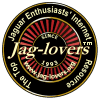|
XJ 40
: 1987-1994 XJ6 & 1992-1994 XJ12
|
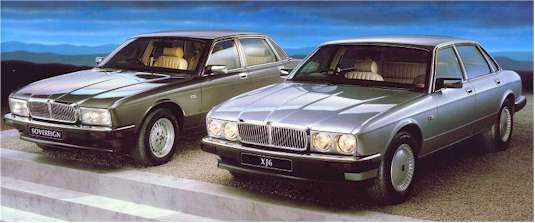
Launched in late 1986 ( early
1987 in the US), the all new XJ6, code named XJ40, was sold under
the same name as its predecessor clearly marking the continuity in
Jaguar offerings despite radical changes. While the XJ40 was much
more modern in appearance with a more linear and rectangular shape,
its
|
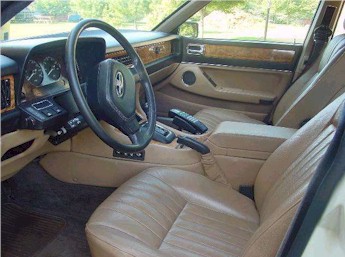
1988 XJ6
interior ( picture Robin & Jim Fergusson)
|
long and tapered lines were pure
Jaguar. The new rectangular headlights (on some versions) and
taillights were among the signs that things has changed since the
first XJ6 was introduced 20 years earlier. Partly beause of
funding issues, the redesign of the XJ6 had lasted longer than usual
having started in the late 70s and while the final design was the
results of Jaguar's own design team, the company had consulted several
Italian styling consultants in the process.
Inside, the familiar round gauges
set against the flat dash panel were gone and replaced by a more contemporary
instrument pod; for the first two years digital gauges were used but
dropped in 1990 and replaced by more reliable analog versions. Craftmanship
in the woodwork and leather upholstery remained as good and refined
as it had always been in a Jaguar. The XJ40 was also the first Jaguar
to feature what would become a Jaguar trademark, the J-Gate gear selector
which offers better control of the automatic transmission.
Changes extended far beyond looks and
styling and mechanically the XJ40 was a completely different cat.
The most obvious change was under the bonnet with an all new engine,
the AJ6, which replaced the classic but now dated XK engine. The new
3.6 liter dual overhead camshafts 24 valve straight 6 produced 221hp
and offered better fuel economy and emmission levels. In Europe,
a 2.9L version was offered as well.
Also new was the rear independent
suspension which had been completely redesigned. Jaguar was among
the first manufacturers to offer independent rear suspension on its
cars and the original design, first introduced on the 1961 E-type,
was still used on the series 3 XJ6 with harder to service inboard
brakes. On the new XJ40 suspension, rotors were moved to a conventional
location near the wheels but less beneficial was the troublesome Self
Levelling Suspension system, discontinued later on in favor
of traditional shocks and springs.
|
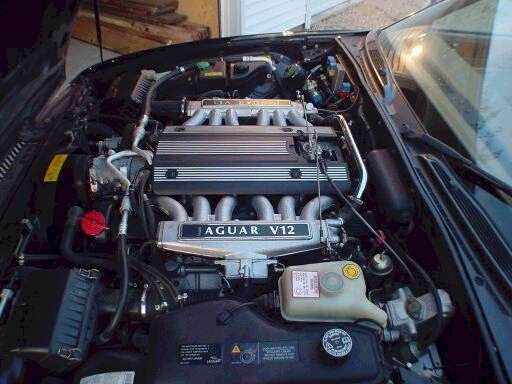
the V12
is rare sight in an XJ40 ( picture Michael Hahne)
|
Interestingly, the Series III
XJ saloon will still be produced for another 3 years for some markets
powered by the V12 engine. Only in 1992, for 2 years, would the V12
engine be used in the XJ40. Originally, the XJ40 engine bay was designed
not to accept any Vee engine, something the designers did to ensure
that then owner British Leyland wouldn't be tempted to use a Rover
V8 to power the new XJ40. It took a substantial redesign of the engine
bay in 1992 for the V12 to fit.
In 1990, the XJ40 received some significant
enhancements, starting with a larger version of the AJ6 engine now
4.0 liters and developping 235hp and while 14hp doesn't seem like
much, the torque increase was a substantial 14%. A new 4 speed automatic,
electronically controled and featuring a sports mode, was developped
along with a new Teeves and antilock braking system.
On the road, even today when well maintained,
the XJ40 is a real Jaguar : smooth, powerful and comfortable made
to cruise effortlessly while its passengers enjoy the luxury... and
its driver enjoys the driving ! The earlier versions of the
XJ40, still under the influence of Jaguar's dark days, had their shares
of problems which were solved with time and the latest cars (92 to
94) are fairly reliable. They are also very well equipped with ABS,
airbags, cruise control, security system and a good sound system.
|
X300 :
1995 - 1997 XJ6 / XJ12 / XJR
|
Early in 1990s and soon after
the 2 1/2 billion dollars purchase of the company by Ford, work begun
on a facelift for the XJ6; the result was the X300 launched in 1995
and still sold under the familiar XJ6 name. It was a back to the roots
design with the return of a more rounded shape with dual healights
flowing into the bonnet. Sleek and tapered lines were still there
of course along with the familiar Jaguar haunches.
|
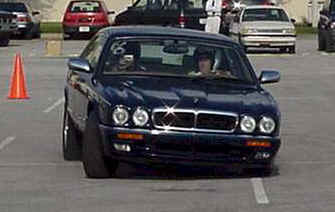
1996 XJ12
in action at a JCNA slalom
|
Mechanically,
the effects of Ford's massive investments in Jaguar were felt with
an all new and much needed electrical system and an updated version
of the AJ6 engine, the 245 hp AJ16. In Europe, a 3.2 liter AJ16 engine
was available.
The interior
of the car was mostly unchanged, a sign of how good the XJ40 interior
was and one of the XJ6 few shortfalls, interior room, was addressed
with a long wheel base version, the XJ6L, featuring an extra 5"
behind the centre pillar.
Driving the
new version reveals the difference, the engine feels more responsive,
delivers more power and better acceleration especially from a stop.
Handling is surprisingly good considering the size of the XJ6 and
its vocation as a luxury car, but again good handling has always been
a characteristic of Jaguars...
In 1996, Jaguar
launched an even more powerful version, the XJR, featuring larger
wheels, improved sports suspension along with minor cosmetic changes
like color coded grille. At the heart of the XJR, the AJ16 engine
received a supercharger giving the 6 cylinder engine an impressive
322hp and 378 ll/ft of torque. Enough power to leave the competition
in the dust while offering Jaguar luxury and styling.
The X300 was
also offered with the Jaguar legendary V12 engine, now enlarged to
6 liters, for those looking for the ultimately smooth motoring experience.
Very few were produced and the V12 engine was permanently retired
at the end of 1996, one year before the AJ16 and the Jaguar tradition
of in line 6 engine would also reach the end of the line.
|
X308 :
1998 -2003 XJ8 / XJR
|
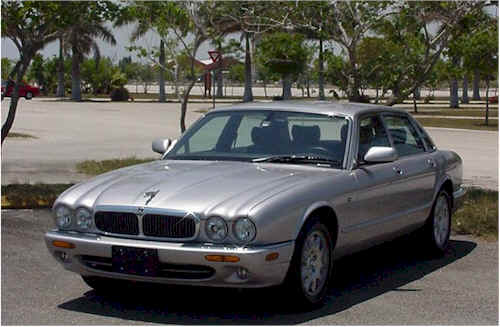 If the switch to
the new aluminium v8 engine marked the end of an era, it also provided
the Jaguar XJ line with more than just a new name. The new V8
engine, first used in the XK8 sports car in 1996, not only brought
more power ( 290hp ) but also a smoother and more refined feeling
to the car. When driving the XJ8, the smoothness of the drivetrain
is evident and in many apects the XJ8 feels nearly as smooth as the
previous XJ12.
If the switch to
the new aluminium v8 engine marked the end of an era, it also provided
the Jaguar XJ line with more than just a new name. The new V8
engine, first used in the XK8 sports car in 1996, not only brought
more power ( 290hp ) but also a smoother and more refined feeling
to the car. When driving the XJ8, the smoothness of the drivetrain
is evident and in many apects the XJ8 feels nearly as smooth as the
previous XJ12.
While the body
style was unchanged from the X300, the interior was completely
redesigned using a dash layout inspired from the XK8 : an uninterupted
veneer panel across the dash with deeply recessed primary instruments.
Once again, despite the changes the traditional British veneer and
leather craftmanships have been kept and this is even more evident
in the long wheelbase Vanden Plas with the lighter wood inset, picnic
tables and piping on the seat.
Building on
the success of the 6 cylinder XJR, Jaguar simultaneously introduced
a V8 powered XJR. The supercharger and twin intercoolers boost the
V8 to 370 hp and 395 lb/ft of torque making the XJR one of the fastest
production saloons in the world. Like its predecessor, the V8 XJR
features a sports suspension, 18" alloy wheel with low profile
Pirellis and color coded trim. A wolf in sheep clothing...
Rarely seen
in the streets is a Supercharged Vanden Plas, introduced in 2000,
which combines the added luxury of the long wheelbase Vanden Plas
with the power of supercharged V8 engine.
